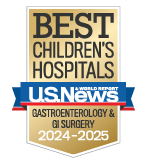Eosinophilic Esophagitis
Nationally ranked by U.S. News & World Report

Eosinophilic Esophagitis
Children’s Mercy helps children and teens with Eosinophilic Esophagitis (often called EoE) to manage this complex digestive system disorder.
What is EoE?
EoE is a type of allergic inflammation in the esophagus often triggered by a reaction to certain foods. While milk and wheat products are the most common culprits, it’s not always clear what the trigger might be.
When a reaction takes place, the body sends a type of white blood cells known as eosinophils into the esophagus, where the cells release chemicals that change the way the esophagus functions.
EoE is more common in kids who have also asthma, eczema and/or allergies.
Symptoms
Symptoms of EoE vary depending on age. Common symptoms include:
-
Nausea and vomiting
-
Food aversion/refusal
-
Abdominal or chest pain
-
Difficulty swallowing
-
Food getting stuck in the esophagus (or feeling as though food is stuck)
- Failure to thrive
Diagnosis and treatment
In order to correctly diagnose EoE, most kids will first try taking gastroesophageal reflux (GER) medications to determine whether the source of the problem is truly EoE or could be caused by acid reflux.
If medications are not effective, your child’s doctor can perform an endoscopy—an outpatient procedure where a thin, flexible tube with a light and camera sends back images of the esophagus to the doctor. The scope can also allow your provider to remove small pieces of tissue for further testing if necessary. For children, this procedure is always done under anesthesia. One of our pediatric anesthesiologists will make sure your child is safe and comfortable the entire time.
Treatment for EoE consists of two main options: swallowed steroid medications to reduce inflammation, or an elimination diet to try to determine which foods are triggering a reaction. While the steroids can help with managing symptoms, the elimination diet, in which any triggering foods are identified and permanently removed from your child’s diet, seems to be the most effective treatment for a long-term solution. Sometimes, allergy patch testing (applying small amounts of possible allergens to your child’s back to check for reactions) is helpful in the process of finding which foods are triggering the reactions.
What to expect at the EoE clinic
Often, kids come to the EoE clinic when they’ve been referred to the Children’s Mercy Gastroenterology (GI) or Allergy clinic and the providers there suspect EoE.
Resources for families
A great source of information is the American Partnership for Eosinophilic Disorders, which has an abundance of resources and links you might find useful.
We encourage any families who are living with EoE, Celiac disease, or food allergies and having difficulty purchasing specialized foods to apply at the Food Equality Initiative. The Food Equality Initiative is a food assistance organization for families whose medical needs require more expensive or hard-to-find foods.
- Gastroenterology
- Celiac Disease
- Constipation and Encopresis
- Feeding Clinic
- GI Procedures: What to Expect
- Inflammatory Bowel Disease
- Intestinal Rehabilitation Program
- Liver Transplant
- Pediatric Abdominal Pain Program
- Pediatric Gastroenterology Fellowship
- Pediatric Motility
- Rumination Disorder Clinic
- Meet the Team
